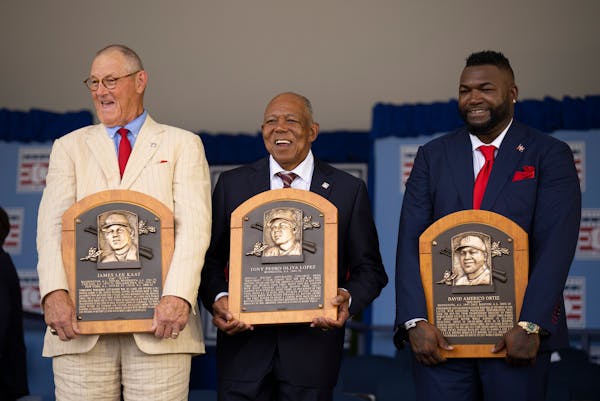COOPERSTOWN, NY. – In their first full day as Baseball Hall of Fame inductees, Jim Kaat, Tony Oliva and David Ortiz shared a stage for a roundtable about their memorable moments.
Kaat talked about how the widow of former White Sox teammate Dick Allen called him to congratulate him for making the Hall even though Allen missed induction by one vote. Kaat pointed out that a one-vote swing could have turned the tables and he would have called her.
Oliva drew laughs as he talked about facing fellow Hall of Famer Sandy Koufax in the 1965 World Series. He drove a Koufax curveball for a double in his first encounter with him. In his next two at-bats, he got five fastballs and missed them all — and he rarely missed two fastballs in the same at-bat.
"After the World Series I came back and told my wife, 'Honey, I have to go check my eyes.' "
Ortiz lamented how Pedro Martinez would strike him out three times when Ortiz was with the Twins, then invite him to his house for dinner.
"At some point, if you can't fight 'em, join 'em," Ortiz said with a shrug. "I'm so glad he brought me to the Red Sox."
It was a time for storytelling as the three new Hall of Famers, in a talk moderated by Peter Gammons, continued to bask in the afterglow of their induction. They took part in front of a few hundred paying fans who had no problem sitting through intermittent showers to listen to story after story. Only when the storm knocked out one of the speakers did the crowd howl.
A couple of their victory laps will take place in the coming weeks. Ortiz left Cooperstown on Monday, with his plaque headed to Fenway Park to be displayed for Boston fans to see. Kaat's and Oliva's plaques will arrive at Target Field on Aug. 6 to be shown during a game against the Blue Jays.
Many of their stories Monday took the audience down different paths. But the group all had similar stories about how they dealt with pitching inside and being pitched inside. It's a practice that occurs less frequently in today's game.
And that was fine with Ortiz.
"I realized everyone wanted to stay away from me," he said. "I did a study six years before I retired about the strike zone, and more than 78 percent of the pitches, they were away. I realized I did not have to worry about the inside part of the plate. And I take advantage of it.
"I see guys nowadays have a hard time pitching in. Everything is away."
Kaat said some hitters, such as Orioles star Frank Robinson, raised their game when they were brushed off the plate. "Tony was like that, too," Kaat added as he looked at his former teammate.
Oliva remembered a game in which Baltimore lefthander Steve Barber hit him with a pitch and knocked him out of the lineup for a few days. When he returned, he was asked to pinch hit and laced a double.
"Every time I got hit," Oliva said, "maybe I was stupid or something [but] I got better."
The Hall of Famers acknowledged that it's hard to pitch inside because of the risk of unintentionally hitting the batter. And umpires today are quick to issue warnings to stop retaliation or escalation. But Ortiz said if a pitcher moved his feet with an inside pitch, he suddenly had to worry about the inside part of the plate.
Kaat agreed, using a story about Reggie Jackson.
"When Reggie came up, we didn't have scouting reports," Kaat said. I said, 'Who is this Jackson kid? He's a lefthanded hitter.' They said he's got good power to the opposite field. So I said to [Twins catcher] Earl Battey, we have to come up and in on him once. I hit the knob of his bat and he went down. Then I threw him a breaking ball and he struck out. I said to Earl, every game I face Reggie, I'm going to come in a time or two.
"Later, [Jackson] said to me, 'I knew you were going to come in there, but I didn't know when.'
"I said, 'That's the point.' "
Settlement could cost NCAA nearly $3 billion; plan to pay athletes would need federal protection
Twins put Buxton on injured list with inflammation in troublesome knee; antsy Lewis still rehabbing

Wolves boss helped build Nuggets into 'best team in the world'

